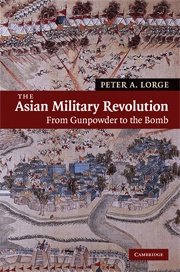Book contents
- Frontmatter
- Contents
- List of maps
- Acknowledgments
- Chronology
- Glossary
- Introduction
- 1 China through the Yuan
- 2 Japan and the wars of unification
- 3 The Chinese military revolution and war in Korea
- 4 Southeast Asia
- 5 South Asia to 1750
- 6 The military revolution in South Asia, 1750–1850
- 7 The arrival and departure of the West
- Conclusion
- Index
- References
3 - The Chinese military revolution and war in Korea
Published online by Cambridge University Press: 05 June 2012
- Frontmatter
- Contents
- List of maps
- Acknowledgments
- Chronology
- Glossary
- Introduction
- 1 China through the Yuan
- 2 Japan and the wars of unification
- 3 The Chinese military revolution and war in Korea
- 4 Southeast Asia
- 5 South Asia to 1750
- 6 The military revolution in South Asia, 1750–1850
- 7 The arrival and departure of the West
- Conclusion
- Index
- References
Summary
We now return to the consideration of China begun in chapter 1, and connect the advances in guns there with the Japanese adoption of Portuguese muskets through Hideyoshi's invasions of Korea in the 1590s. Although guns were widely available in the struggle for supremacy in China during the mid-fourteenth century, they became a cornerstone of the Ming army only after the Ming conquest of China. Before the end of the fourteenth century, almost 10 percent of the army's 1.2–1.8 million soldiers were armed with guns. The capital's arsenals produced 3,000 cannon and 3,000 handguns annually from 1380 to 1488. These weapons were widely deployed and initially gave Ming armies an advantage over neighboring states that were not so armed. European advances in gun technology were quickly adopted in China, and the cannon it brought into the field owed as much to the West as did the Japanese army's muskets.
Hideyoshi's invasions of Korea brought about a direct clash between three different gun-armed forces, the Japanese, Chinese, and Koreans. Japanese forces were armed with muskets and trained in volley fire; Chinese forces relied upon cannon; and Korean forces used cannon on armored warships to interdict Japanese maritime supply lines. On the strategic level, the Japanese were completely defeated, achieving none of their political or military goals at a tremendous loss of life. Tactically, the results were more mixed. Chinese armies succeeded when they brought their cannon up to the battlefield, and lost when they did not.
- Type
- Chapter
- Information
- The Asian Military RevolutionFrom Gunpowder to the Bomb, pp. 66 - 87Publisher: Cambridge University PressPrint publication year: 2008

